If you’re listening to the audio, can I just apologise to any Korean nationals for my appalling mispronunciation of the Korean words 😱 - in fact for all of the mistakes - it’s harder than it seems to not trip over one’s words, I have a new respect for Audible narrators!
The plot thickens. The deeper I delve into Kimchi from all angles, the more fascinating I find it…. So while in general there is definitely more to fermentation than kimchi, at the moment there isn’t! In this issue, cabbages, gochugaru and radishes.
We’ve established that some cultural and historical understanding can in itself make us better kimchi makers, but what about practical limitations we face in our quest for authenticity? We’re influenced by the ingredients available to us, so let’s look at some of these in detail (but do remember, in part 2 we covered that kimchi’s wide definition means that you can omit/make substitutions for at least some of these and still make kimchi – click here to refresh your memory) –
Cabbage
Napa Cabbage (or Chinese leaf lettuce), one of the most prominent components of kimchi (certainly as we know it here) was introduced to Korea somewhere between the 13th and 18th centuries depending upon what you read. In their natural state, these are enormous vegetables – huge – and a vibrant green; much bigger than the tiny, pallid 500g hearts found in British supermarkets, which usually come from Spain or Portugal.
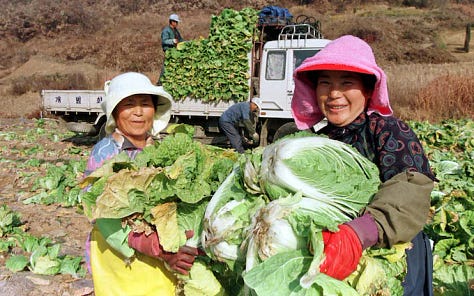
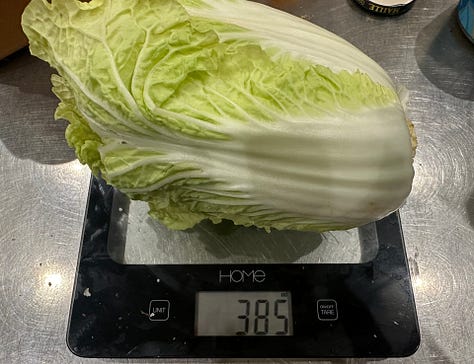
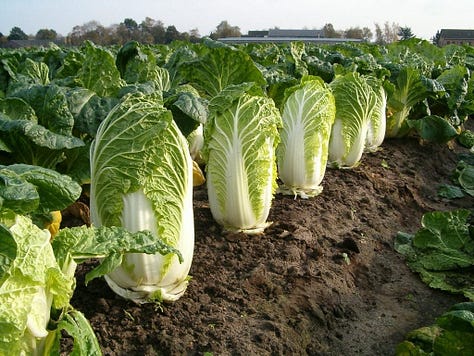
In a large specialist supermarket (like Wai Yee Hong near the M32) you may find more impressive specimens up to 4 times the size. They’re still from Europe but they clearly are aimed at a different market – a bit like going to Brewer’s for trade paints, or buying catering-quality equipment – there are definitely two levels when it comes to Napa cabbage. The finest batch I ever came across was during my kimchi-production days – they were pink, and relatively locally grown in Lincolnshire - I made white kimchi so I wouldn’t lose the glorious colour. Sadly I’ve never come across them again; if you see them, don’t pass them by!

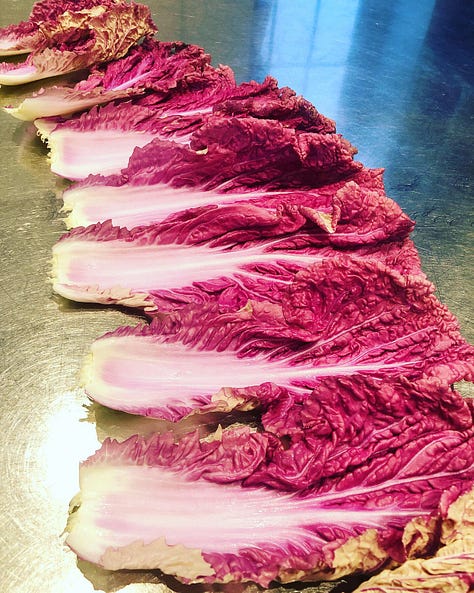
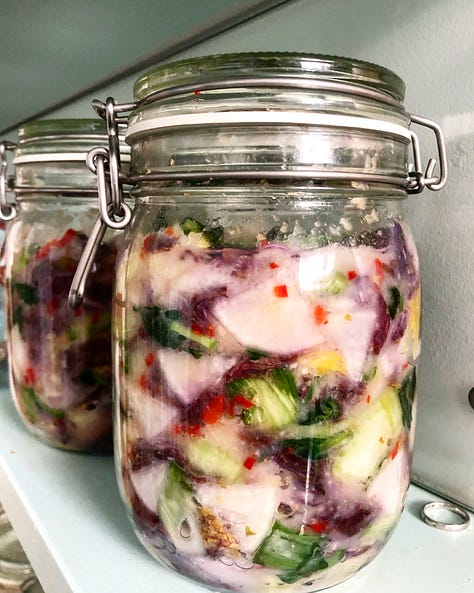
In Korea, Napa cabbage is grown at high altitudes, exposed to extremes of temperature from 6-20 oC which confers a robustness rendering the fibres suitable for long term storage without softening. If it hasn’t been grown under these conditions, the resulting leaves can soften incredibly quickly when fermented, even if salted at high concentrations to remove much of the water, and this becomes even more marked when kimchi is attempted at higher than room temperature.
If you are overcome with a burning desire to make kimchi in the heat of the summer (what summer), I recommend a short ferment of just 3-4 days at a the coolest room temperature you can muster – you could use an icebox filled with slightly cooled water to help - followed by fridge ageing and eating it fairly quickly – usually within 4 months. These days I include more salt in my recipe as it also seems to help (we’ll cover this is another edition).
Our home-grown varieties of cabbage -the more sulphurous white, red and green, are eminently suitable for long-lasting kimchi, with their stronger taste adding additional flavour and long-lasting texture. Hispi cabbage is good too, and can be used for a version of whole-leaf kimchi, just cut the cabbage into quarters and smear kimchi paste between the leaves. Savoy cabbage needs some work, especially if it’s home grown with tough dark green leaves, which ferment very slowly because the high levels of chlorophyll they contain can inhibit fermentation. If you want to use the darkest foliage, I’d recommend mixing it 50/50 with some white or hispi cabbage to speed things up a bit.
I usually call a white cabbage kimchi kimchi-kraut because it has the texture of one and the taste of the other, but it does have a proper name: Yangbaechu Kimchi. In history of kimchi, this is a very recent recipe, popularised by Koreans living abroad who couldn’t find Napa cabbage and substituted white cabbage instead. I cannot describe just how delicious it is, nor explain exactly why the cabbage substitution works so well, but I really reccommend it!
When using more cabbagy cabbages (for want of a better term) than Chinese leaf lettuce, it isn’t as important to salt soak them as they’re not as full of water. Make up your kimchi by mixing all the vegetables together, ensuring you’ve used 2% salt throughout.
Gochugaru (Korean Red Pepper Powder)
This spicy dark red powder defines kimchi for most of us. It’s widely believed that chillis were introduced via trade routes from Central America via Portugal to Japan and then to Korea, in the 16th Century when Japan invaded and that until this time, kimchi was white or green, made with brassicas and radishes. However this is hotly contested by Kwon et al (2014), who maintain that the Korean gochu chilli is unrelated to those of Central America and has been present on the Korean Peninsula for millennia, having been spread by birds… in any case, whichever story you choose to believe, baek (white) kimchi is commonly believed to be the predecessor of the red version.
Gochugaru (gochu meaning chilli pepper, garu, powder) is made from dried taeyang-cho peppers, which are a variety of Capsicum annum, the same species that contains red peppers, jalapenos, bird’s eye and many other types of chilli. They have a unique flavour profile, with hints of paprika, a certain sweetness, and a surprisingly low scoville rating of 1500-2000.
It’s difficult to find a substitute – certainly in Korea this wouldn’t even be attempted. *** EDIT - actually, I’ve since learned that this isn’t strictly true! More typical fresh red chillis can certainly be added, either to white kimchi for children, to introduce a presence of, rather than dominance of heat, or for additional aromatic effect. ***. Fortunately it’s very easy to find these days either at Korean or Chinese supermarkets or online. Sometimes the fine version is made from the far hotter cheyonyang pepper, and it’s not always obvious from the packet. I recommend opting for the coarse red pepper powder to be on the safe side.
My brand of choice these days is Wang - I used to use one called Nongshim Farmer’s Heart which has mysteriously c disappeared from the shelves. Want gochugaru is a pure ingredient – i.e. 100% dried red chilli – beware other varieties that could contain unnecessary additives or preservatives. Like much of the exported gochugaru this is produced in China and packaged in South Korea. Organic gochugaru, is like hen’s teeth – it doesn’t really exist. Several British fermenters have investigated with local chilli growers whether gochugaru could be grown here, but the consensus of opinion is that the terroir is so important to the finished product, it wouldn’t taste the same.

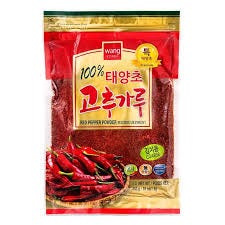
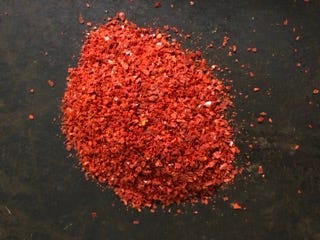
All gochugaru is dried, but look out for the words “taekyung” or “taeyangcho” which denotes that the product is sun-dried, thus with a better flavour and of higher quality.
Gochugaru can be hot, but not to the same extent as eating a vindaloo – kimchi’s heat is said to be more ephemeral than the spiciness. The effect of the chilli powder is additive, so the easiest way to reduce the heat of your kimchi is to reduce the amount of gochugaru you add – there’s quite a lot of leeway while still maintaining the colour. I tend to use 50g per 1000g of raw ingredients which gives a good balance. To the Korean palate, 100g per kilo would be more acceptable!
A whole alternative world of kimchi is available to you if you simply leave the red pepper powder out, BUT do be aware that in addition to the obvious benefits of flavour and colour the gochugaru powder does itself play an important role in the development of the microbial complexity of kimchi, stimulating the growth of especially Weissella sp (a type of lactic acid bacteria), and it’s also able to suppress the growth of pathogenic microbes and fungi, so can enhance the preservative effects of the lactic acid produced during fermentation.
Radishes





Radishes have been a component of kimchi since its inception and were probably initially the only ingredient. You can make a simple white radish kimchi called dongchimi just using radishes and a little garlic and spring onion with a salt brine.
Our dear little round red radishes look pretty different to the those typically used in kimchi – real Korean daikons are like a large sweet potato in size, with pale green skins fading to white. These are tricky to find here, so most of us substitute the larger, longer daikon radish instead – these enormous things are often quite hairy so I used to peel them (it can actually look like there’s hair in your kimchi!) but I have recently learned an interesting fact regarding radishes – it might be better to give them a light scrub and keep the skins on, as they are said to contain a compound that can help maintain crispness when it’s fermented.
Can you substitute our red radishes for daikon? Yes you certainly can – but they seem to lose their texture more rapidly than the daikon radishes so don’t slice them too thinly. I suspect they have a different cell wall composition. Flavourwise, if you’re making a red kimchi, you mightn’t notice the difference but red radishes are far milder in both smell and flavour. You can also substitute turnips, which have a texture more akin to Korean radishes.
Did you know that radishes are cruciferous vegetables and therefore part of the Brassica family, with cabbages, cauliflower and turnips? Now, all brassicas are full of phytoactive components with a range of therapeutic effects and radishes are no exception - they’re rich in glucosinolates, compounds which are responsible for the pungent smell and (in vitro) have anti-microbial, anti-fungal anti-cancer-cell-proliferation activity1.
Daikon radishes contain over 96% water, but it is still not common practice to soak them along with the cabbage when making kimchi – this could be due to the absolutely horrible smell they emit when treated in this way, or because they do end up absorbing an awful lot of salt and don’t give up much of their integral water – probably something to do with their particular cell structure. I was never taught to include the daikon radish when salting, but if you want to see if it makes a difference to your kimchi, just add them in for the last hour of soaking. They’ll lose some water and not absorb too much salt. My process has always been to instead ensure that all soaked components are well drained and over the coming weeks, allow the continued osmosis caused by the salt to slowly draw out a little water from the radishes, keeping the kimchi moist.
That’s quite enough to take in for one Substack! More kimchi hints and tips coming soon.
KIMCHI MASTERCLASS WORKSHOP
I’ve had a cancellation for the kimchi masterclass on June 29th with Rebecca Ghim so there is one space available - could possibly squeeze in another if you wanted to come with a friend - please email me if so, otherwise the ticket can be booked HERE !
REFS
1 - Cruciferous Vegetables: PMID 34764875

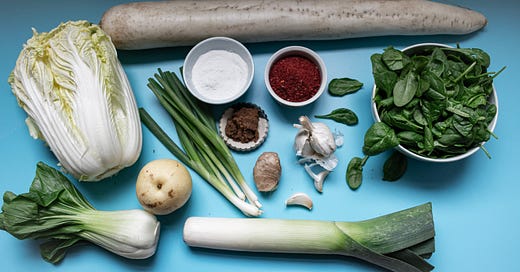




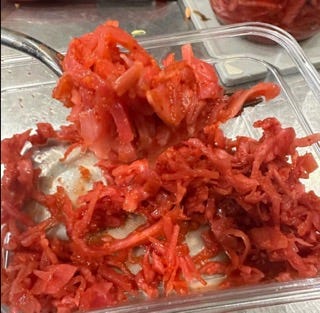

heartened to know Napas grow at such low temps - you’d think I had perfect conditions but last years attempts resulted in early flowering or slug parties
Thank you for such fascinating information!
Really looking forward to the 29th 🌶️